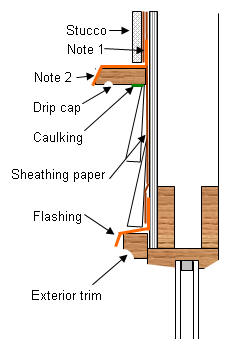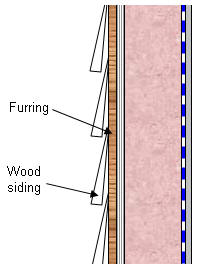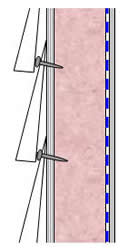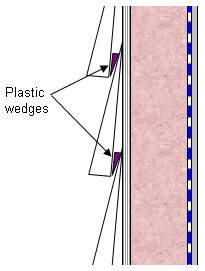Problem: Water penetration through siding.
Cause: Poor drainage of wall elements and inadequate drips at sills or joints.
Solutions:
- Ensure that rainwater is prevented from moving inward toward the wall cavity and that positive drainage is provided.
- Install flashing at the head of door and window frames and where two wall materials meet as shown in Figure 34.

Figure 34 - Flashing installation
- Note 1: Lap sheathing paper over flashing.
- Note 2: Flashing complete with drip
- Provide adequate outward slopes to window and door sills.
- Provide saw kerfs or formed chases to stop capillary action that can draw rainwater up the underside of window and door sills and into the siding.
- Create 1/8 inch (3 mm) gaps in the lap joints of horizontal siding. The gaps can be achieved with round-headed nails or wedges as shown in Figure 35a, 35b and 35c.

Figure 35a - Creating Gaps In Lap Joints
Gaps measuring 1/8 inch (2.5 to 3 mm) allow air to enter, raising the pressure to equal the outside pressure and allowing the siding to breathe.
These gaps also eliminate surface tension, which prevents water from entering the wall by capillary action.

Figure 35b - Creating Gaps In lap Joints
Round-headed nails provide an air space, allowing the siding to breathe and giving it the pressure to equalize with the exterior. They also restrict water penetration by capillary action.

Figure 35c - Creating Gaps In lap Joints
Use plastic wedges between the siding laps at each stud to provide air space.
